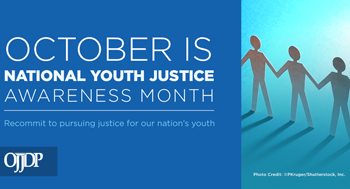 On September 30, 2015, President Barack Obama issued a proclamation designating October as National Youth Justice Awareness Month.
On September 30, 2015, President Barack Obama issued a proclamation designating October as National Youth Justice Awareness Month.
OJJDP applauds the President for highlighting the challenges—and the many opportunities for reform—in the area of juvenile justice. For more than four decades, OJJDP has worked with states, as well as tribal and local jurisdictions, to prevent delinquency, reduce recidivism, and improve outcomes for youth, families, and communities. Although there has been significant progress, much work remains to be done.
Each year, more than 1 million young people are arrested, most of them for nonviolent crimes. Any involvement with the juvenile justice system, even if a young person is not adjudicated delinquent, can interfere with the ability to get an education, find a job, or secure housing.
Furthermore, nearly 55,000 youth are currently held in juvenile justice facilities, even though research has shown that positive outcomes for nonviolent youth and for public safety are more readily achieved through community-based services, at a fraction of the cost of incarceration.
—President Barack Obama
In addition, more than 5,000 youth are currently placed in adult jails and prisons, even though research shows that youth in the juvenile justice system are less likely to reoffend than young people who are transferred into the adult system.
OJJDP’s ongoing work to address these and other issues related to youth justice, includes sponsoring research, providing funding, and implementing initiatives that make a real difference in youth’s lives.
Research
Commissioned by OJJDP, the National Academies report, Implementing Juvenile Justice Reform, recommends a strategic plan for the federal government to facilitate developmentally oriented juvenile justice reform.
The Office also supports the Northwestern Juvenile Project, a longitudinal study that investigates the mental health needs and long-term outcomes of youth detained in the juvenile justice system.
Youth Engagement
OJJDP’s National Girls Initiative focuses on catalyzing change for girls in, and at risk of entering, the juvenile justice system.
The Police and Youth Engagement: Supporting the Role of Law Enforcement in Juvenile Justice Reform award will support the convening of a youth and law enforcement roundtable and the development of an institute for disseminating best practices for building bridges between youth and law enforcement.
The Office has long supported mentoring as an effective way to prevent at-risk youth from becoming involved in delinquency; mentoring appropriations totaled approximately $690 million from fiscal years 2008 to 2015.
Reform Initiatives
OJJDP’s Smart on Juvenile Justice strategy focuses on implementing statewide juvenile justice reforms that emphasize prevention and cost-effective community-based services as an alternative to placing nonviolent youth in juvenile justice facilities.
A collaborative project between the Departments of Justice (DOJ) and Education (ED), the Supportive School Discipline Initiative, promotes the use of school discipline practices that foster safe, supportive, and productive learning environments.
A DOJ-ED guidance package released by the two Departments last year includes recommendations and federal requirements for ensuring that youth in confinement receive an education comparable to those provided in traditional public school settings.
Resources:
To learn more about OJJDP’s initiatives to prevent and address youth violence and gang involvement, visit the OJJDP website.
